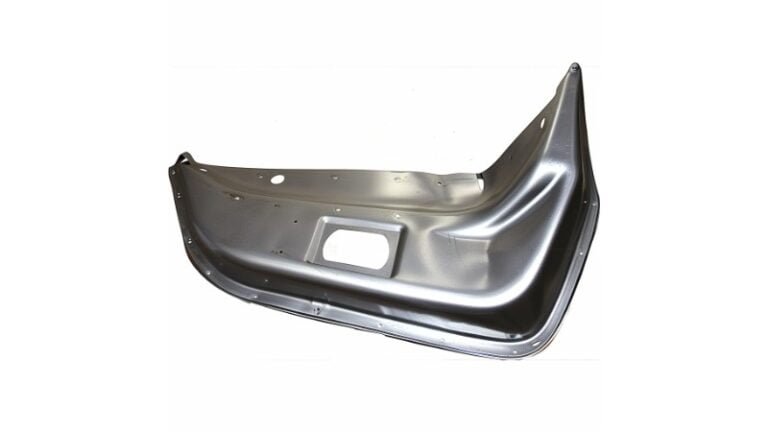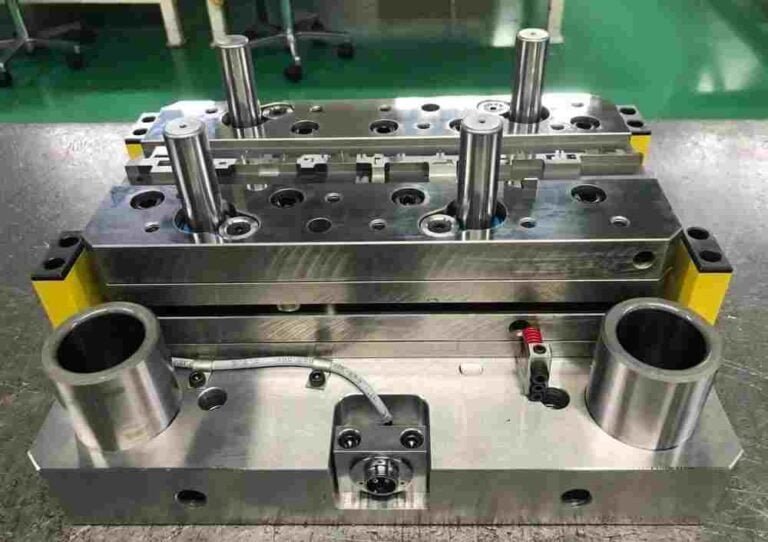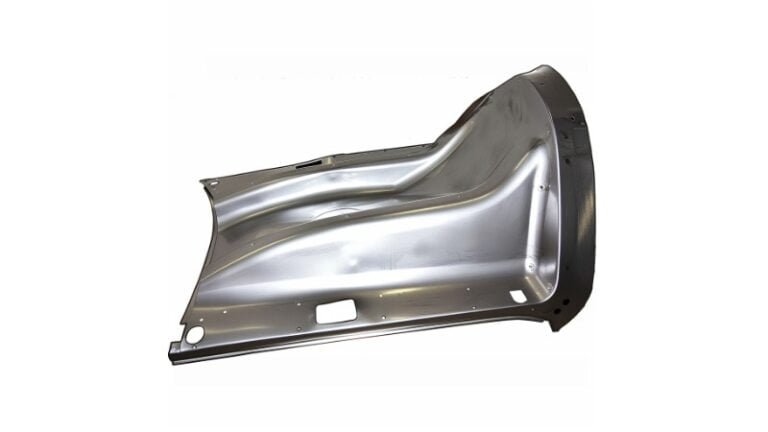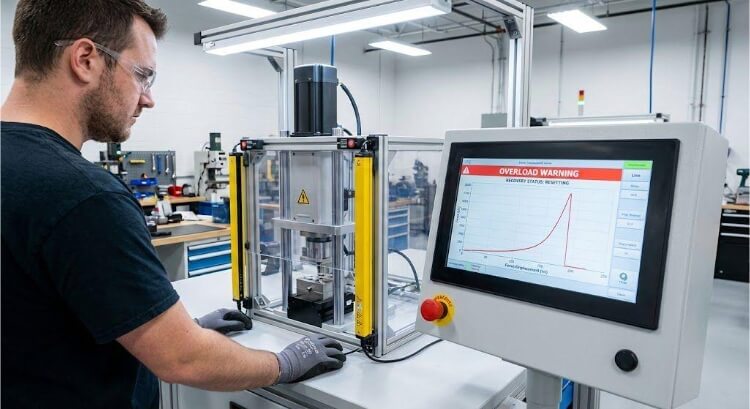Have you ever faced challenges in achieving complex metal shapes with precision and consistency? Many manufacturers struggle to produce intricate designs efficiently. This can lead to delays, increased costs, and compromised quality. The process often feels daunting and frustrating, leaving you searching for a reliable solution. Deep drawn stamping is the answer.
Are you curious about how it works? Let’s get into the details.

Deep Drawn Stamping Fundamentals
What is Deep Drawn Stamping?
The deep drawn stamping process is an efficient metal-forming method that creates complex shapes efficiently and precisely. This process involves drawing a blank metal sheet into a forming tool and transforming it into intricate designs. This method produces high-quality components at lower costs, particularly for large production runs.
Understanding the Process
Basic Principles
This process begins with a sheet of flat metal. This sheet is placed into a die, and a punch shapes the metal. This allows the metal sheet to stretch and flow without cutting or welding, creating a solid and seamless final product.
Key Terms
- Blank: A flat sheet of metal used to start the process.
- Die: A tool that is used to form metal. It consists of a cavity into which the blank can b e drawn.
- Punch: Component that forces the metal blanks into the die.
- Drawing: Forming the metal by pulling the punch into the die.
Deep Drawn Stamping Materials
Common Metals
Deep-drawn stamping is commonly done with aluminum, stainless, copper, and brass metals. Each metal has unique properties that make it suitable for various applications.
Material Properties
- Aluminum: Lightweight, corrosion-resistant aluminum alloy ideal for aerospace and automotive components.
- Stainless Steel: Strong and resistant against rust. Perfect for kitchen sinks, medical devices, and other items.
- Copper: Excellent conductivity and is used in electronic components
- Brass: Excellent machinability, corrosion resistance, and suitable for decorative and Plumbing Fixtures.
Tools and Equipment
Die Sets
The die sets are essential for deep drawn stamping. These sets consist of a punch, a die, and other components which shape the metal. To achieve consistent and accurate results, die design must be precise.
Press Machines
Press machines use the force necessary to pull the metal into the dies. Depending on the size and complexity of the part, we use different types of press machines. Hydraulic presses have a reputation for applying pressure and consistently producing high-quality results.

Deep Drawing Metal Stamping: How it Works
Step 1: Secure Metal Sheet
A blank, or flat metal sheet, is secured before the deep drawing begins. The blank is placed on a die that will shape the metal.
Step 2: Punching
After the metal sheet has been secured, we will use a punch to press it into the die. The punch draws the metal into the die cavity by applying force. The step can be repeated several times to draw the metal into the desired shape.
Step 3: Get Product
We remove the new product after fully drawing the metal into the die. The finished product has a hollow, seamless shape with intricate detail. Depending on the design, additional finishing processes can be used to achieve the desired surface qualities and dimensions.
Deep Drawing Techniques
Single Draw
The metal sheet is drawn into the desired form in a single step. This method is best suited for parts that have shallower, simpler designs. Single-draw is cost-effective and efficient, which makes it ideal for large-scale production runs.
Multiple Draw
We use multiple drawing techniques for more complex shapes and deeper parts. The process involves drawing the metal in several stages, gradually forming it into its final shape. Each successive stage increases the complexity or depth of the part. Multiple draws ensure greater precision and lower the risk of defects such as tearing, wrinkling, or tearing, especially when designing intricate designs.
Redraw
Redrawing is the solution when the first draw fails to achieve the desired shape or depth. This method involves reinserting the partially drawn piece into a new die to shape it further. Redrawing gives us greater precision and flexibility, allowing us to make more profound or complex components.

Helpful Design Tips for Sheet Metal Deep Drawing
Material Selection
A suitable material selection is essential for a successful deep drawing. Consider factors such as tensile, thickness, and flexibility. Deep drawing is famous for metals such as aluminum, stainless steel, and copper.
Corner Radius
To avoid metal tearing, it is essential to design corners with a radius that allows for smooth metal flow. Sharp corners can lead to stress concentration and cracks. To improve the quality of your parts, we recommend generous radii.
Draw Ratio
The draw ratio is an important parameter. It is the ratio between the diameter of the blank and the diameter of the punch. The draw ratio is essential to prevent tearing and wrinkles. We typically aim for a ratio of 1.5:1 to 2:1 for optimal results.
Blank Holder Force
The blank holder forces the metal sheet to be held during drawing. This prevents wrinkles and controls material flow. Adjusting the force according to material properties and part geometries is essential to achieve a quality final product.
Lubricants
Lubrication between the metal sheeting and the die reduces friction, which minimizes the risk of tearing. It also improves the flow of material. We use lubricants suitable for the metal type to ensure a smooth drawing process.
Tooling Design
The precision of tooling design is essential. Die and punches must be manufactured accurately to achieve the desired dimensions and shape. We also consider factors such as clearance, punch speed, and pressure to improve the drawing process.
Testing and prototyping
Testing and prototyping are essential before full-scale production. Prototypes are created to help us identify problems and make adjustments. This ensures that the final product will meet design specifications and standards.
Deep Drawn Stamping: Benefits and Advantages
Deep-drawn stamping has several benefits.
- Efficiency: We can produce large quantities quickly, making it perfect for mass production.
- Cost Effectiveness: Reduced material waste and labor costs result in significant savings.
- Quality: This process produces parts of high quality and precision dimensions.
Challenges and Solutions
Deep Drawing: Common challenges
Material Cracking
Deep drawing is often plagued by material cracking. This occurs when metal is stretched past its tensile strengths, causing fractures. Improper material selection, excessive drawing ratios, or inadequate lubrication may cause the problem.
Wrinkling
When the metal sheet is improperly held during the drawing process, it can cause wrinkles. This can be due to insufficient blank holder force or incorrect die design. The final product’s quality and appearance can be affected by wrinkles.
Innovative Solutions
Choose from a wide range of Advanced Materials.
Selecting suitable materials can reduce the likelihood of cracking, among other problems. Materials with high flexibility, appropriate mechanical properties, and a high degree of flexibility can withstand deep tensile stress better.
Improved Tooling Techniques
Deep drawing problems can be addressed with innovative tooling techniques. Precision-engineered punches and dies, for example, can reduce defects and ensure a smoother metal flow.
What is the Difference Between Deep Drawing and Stamping?
This table explains the differences between deep drawing (deep drawing) and stamping to help you better understand their respective applications and advantages.
| Feature | Deep Drawing | Stamping |
|---|---|---|
| Process | Involves drawing sheet metal into a die to create deep, hollow shapes | Involves cutting, bending, and forming sheet metal into desired shapes using dies and punches |
| Complexity | Suitable for creating complex, deep, and seamless shapes | Suitable for simpler shapes, often requires additional processes for complex parts |
| Material Efficiency | High material utilization with minimal waste | Can result in more material waste, especially in cutting processes |
| Strength | Produces strong, seamless components with work-hardened properties | Strength depends on the process; welded or riveted parts may have weaker joints |
| Surface Finish | Generally produces smooth, high-quality finishes | Surface finish may require additional finishing processes like polishing or coating |
| Production Speed | Efficient for high-volume production of complex parts | Also efficient for high-volume production, but complexity and additional processes can slow it down |
| Cost | Higher initial tooling cost, but lower per-unit cost for large volumes | Lower initial tooling cost, but per-unit cost can be higher for complex shapes |
| Seamlessness | Produces seamless components, reducing potential failure points | May require welding or riveting, which can introduce weak points |
Applications and Industries
Automotive Industry
- Fuel tanks
- Engine components
- Exhaust systems
- Weight loss
- Strengthened strength
- Cost-effective Production
Aerospace Industry
- Aircraft panels
- Structural components
- Engine housings
- Fuselage sections
- Wing ribs
- Landing gear parts
Consumer Goods
- Kitchen sinks
- Cookware
- Metal enclosures
- Consistent quality
- Efficient production
- Cost Savings
Medical Devices
- Surgical Instruments
- Medical housings
- Implantable components
- Pacemaker Cases
- Catheter components
- Housings for diagnostic equipment
Possible Deep Drawn Stamping Tolerances
These tolerances guarantee high precision and quality for deep drawn stamping. They meet the needs of different industries and applications.
| Tolerance Type | Typical Range |
|---|---|
| Dimensional Tolerance | +/- 0.1 mm to +/- 0.5 mm |
| Thickness Tolerance | +/- 10% of material thickness |
| Flatness Tolerance | 0.1 mm per 100 mm |
| Hole Diameter Tolerance | +/- 0.05 mm to +/- 0.2 mm |
| Forming Radius Tolerance | +/- 0.2 mm to +/- 0.5 mm |
| Concentricity Tolerance | +/- 0.1 mm to +/- 0.3 mm |
| Position Tolerance | +/- 0.2 mm to +/- 0.5 mm |
Conclusion
Deep-drawn stamping can be a very versatile and efficient method of metal forming. It produces seamless, vital parts with little scrap. It is the preferred method for manufacturing automotive, aerospace, consumer goods, and medical devices. Understanding the benefits and applications of deep-drawn stamping will help us to use this technology in our projects.
Do you need a reliable sheet metal parts manufacturer? Shengen is the place to go. We specialize in sheet metal laser cutting, bending, surface finish, and CNC Machining. Reach out to Shengen Today and seek help from professionals!
FAQs
How deep can metal be stamped?
The depth of the stamping is determined by both material and design. It can range from 1 to 12 in. For deeper or more complicated shapes, multiple drawing stages may be required.
What industries are the biggest beneficiaries of deep drawn stamping technology?
Automotive, aerospace, consumer products, and medical devices are among the industries that can benefit most from deep drawn stamping. Deep-drawn stamping is a great way to produce high-quality, durable, cost-effective parts for these sectors.
How can manufacturers overcome common challenges when deep drawn stamping?
Manufacturers can overcome many common challenges by selecting suitable materials, optimizing tooling design, controlling process parameters, and using advanced lubricants. Prototyping and implementing rigorous quality control can help identify potential problems early in the production cycle.
More Resources:
Draw reduction calculations – Source: The Fabricator
Deep Draw Tooling Design – Source: ATACO
Cost-Efficient Stamping – Source: Manortool
Hey, I'm Kevin Lee

For the past 10 years, I’ve been immersed in various forms of sheet metal fabrication, sharing cool insights here from my experiences across diverse workshops.
Get in touch

Kevin Lee
I have over ten years of professional experience in sheet metal fabrication, specializing in laser cutting, bending, welding, and surface treatment techniques. As the Technical Director at Shengen, I am committed to solving complex manufacturing challenges and driving innovation and quality in each project.




